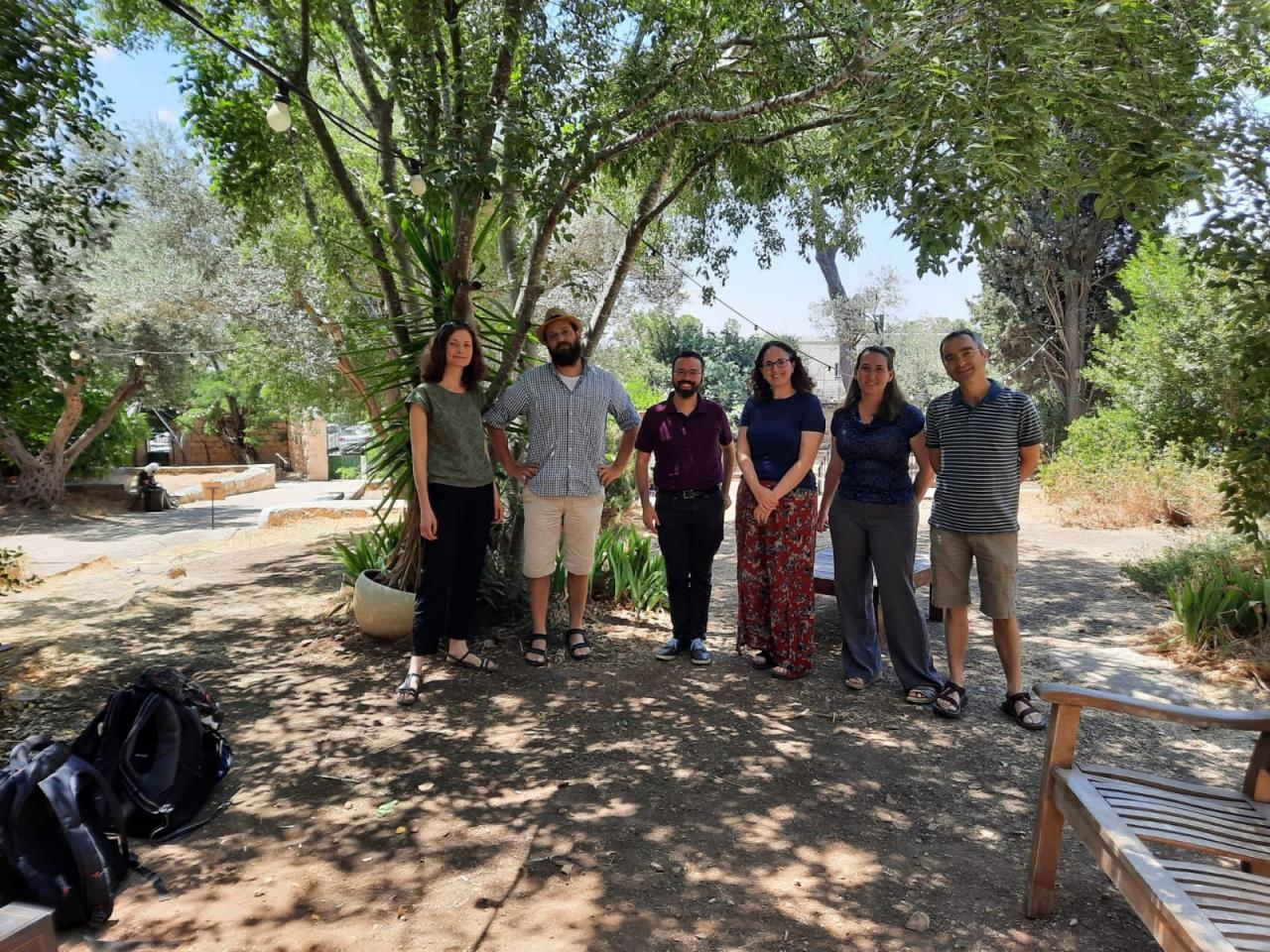Research Groups
The Center offers support to research groups for postdoctoral students, each of whom is granted a stipend. The topic of the research groups is announced in a formal Call for Applications, and an official vetting process.
Read more about the 2020-2021 Research Group on Rituals and Spaces in Jewish Communities, 1200-1900

Research Fellows from left to right: Hadar Feldman-Samet, Yakov Mayer, Tzafrir Barzilay, Ahuva Liberles-Noiman, Moshe Yagur.
Dr. Tzafrir Barzilay is interested in the development of the common perceptions of Jews and Christians, and how these evolved throughout the Middle Ages, in particular around the subject of water. In 2016, he received a PhD from Columbia University in New York. He is the author of Poisoned Wells: Accusation, Persecution and Minorities in Medieval Europe, 1321-1422 (University of Pennsylvania Press, 2022). Barzilay is currently investigating lay beliefs and practices pertaining to water in Jewish and Christian life from 1050 to 1450 in Europe, focusing on the tensions between the different meanings attributed to water by Jews and Christians in the context of its wide range of practical and ritual uses. He is also studying the roles that rivers played in shaping the history of medieval European Jews.
Dr. Moshe Yagur: During the 2020-2021 academic year, as a fellow at the Halpern Center, I studied the issue of Jewish dwelling options and choices in the urban centers of the medieval Islamic Middle East. I used Cairo Geniza documents alongside contemporaneous sources and archaeological information. Specifically, I questioned the concept of 'Jewish neighborhood' in the Middle Eastern context. What made a neighborhood 'Jewish' – the percentage of Jews in it? The distribution of Jews between it and other parts of the city? The location of Jewish institutions in it? Why in some cities do we find a neighborhood which is identified by the residents as 'Jewish', while in other cities we can't find such a description? And how should we, as modern historians, use the term 'Jewish neighborhood' in an accurate and useful manner, in light of these questions?
Dr. Ahuva Liberles Noiman received her Ph.D. from the Hebrew University of Jerusalem. Her research at the Halpern Center was entitled “Making Jewish law accessible to the physically impaired: Adele's journey to the 15th-century Bavarian Mikveh. Her project examins the religious actions of a medieval Jewish woman from Bavaria, who was paralyzed from the spine down - probably as a result of an illness. By joining forces with local rabbinic leadership in the 15th century, they uncovered a path to allow her to fulfill her religious obligations despite her physical dissabilities. Drawing on archival and responsa literature, this study uncovers the medieval roots of the struggle to make Jewish law accessible and highlights the "bottom up" agency, giving voice to women of the past.
Dr. Yakov Z. Mayer worked on MS Oppenheim 726 and the Temple in Medieval Ashkenaz.
MS Oppenheim 726 (Neubauer 370) - today part of the Oppenheim collection in the Bodleian library in Oxford - contains a unique collection of medieval compositions that deal with different legal aspects of the temple in Jerusalem, and its sacrificing ceremonies. Among them are miscellanea of paragraphs of Mishnah and Talmud, their medieval commentators, and various legal decisions of medieval halakhic rulers. The manuscript was circulated probably among Hasidei Ashkenaz, whose political and theological point of view was built upon an intensive studying of the temple and its rituals. This study aims to create a biography of the manuscript, including full codicological and paleographical analysis, and historical contextualization. I wish to build a profile of its creators and readers, and to understand what was the role of this book on the book shelf.
My argument is that this manuscript reflects a medieval perception of the “holy place” and the rituals surrounding it. Unlike medieval handbooks for pilgrims, or memoirs of pilgrims, which are documenting physical movement in space towards the holy place, this manuscript was used as a mental guide. Its purpose was to set an emotional, intellectual and mental connection with the holy place, while the physical spatial aspects of the place remained far from reach.
Dr. Hadar Feldman Samet studies the cultural and social history of Jews in Islamic contexts, especially that of the Sephardi Jews of the Eastern Mediterranean basin and the Ottoman Empire. After completing her doctoral research at the Hebrew University, which explored the Sabbatian movement in the Ottoman context in the nineteenth century, Her project as a Halpern Center fellow (2020-2021) reflects her broader interest in intercultural and interreligious encounters, and the affinities between elite and popular cultures, and between social revolutionism and everyday life. The project examines the ways in which emotional expressions and musical traditions, which were widespread in the Ottoman culture in 17th-19th centuries, shaped ritual practices in the Sabbatian movement, in particular, and in the surrounding Jewish and Muslim societies, in general. This study seeks to show that ritual sources can serve as a unique – and at times exclusive – source for exposing significant aspects of commoners’ daily culture, while concurrently shedding light on various cultural exchanges between ethnic groups.



